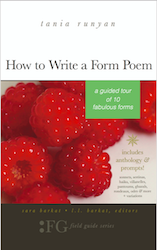Poet-a-Day: Meet Celia Lisset Alvarez
I ran across Celia Lisset Alvarez’s “Lizards” while reading the wonderful anthology Obsession: Sestinas in the Twenty-First Century. Right away, I knew I needed to highlight this poem in How to Write a Form Poem, as a masterful sestina—and was thrilled to get Alvarez’s permission to reprint. It’s become one of my favorite poems in the book!
Since contacting Alvarez about her poem, I’ve enjoyed getting to know her as a spirited and generous poet. Here are the first two stanzas of “Lizards.” If you want to read the rest (and you will), check it out in How to Write a Form Poem!
Lizards (excerpt)
They’re perfect killing machines,
you said to me, dead serious, scheming
something about their silent universe,
the constant shock of their existence.
Despite living your whole life in Florida,
you thought your house impermeable.
In a shoe or on a towel, in your impermeable
mind, they broke up the model-home machine
in which you lived. If you’re going to live in Florida
was not something you wanted to hear, scheming
how to stop the arrogant intruders from existing,
how to cast out their soft souls from your universe…
—Celia Lisset Alvarez
Here’s what the poet has to say, quite vividly, about her creepy crawly poem…
Tania Runyan (TR): Tell me a little about the origin story of “Lizards”:
Celia Lisset Alvarez (CLA): First of all, you must understand that I am really TERRIFIED of lizards. It is a phobia. Every emotion expressed in this poem about their wily threat is 100% real. I’ve never lived outside of Florida, so I don’t know how they organize in other areas, but here they’re big as chihuahuas and there’re 100 lizards for every human. I have a palm tree in my backyard I call the Falling Lizard tree because they literally pour like a constant fountain from top to bottom and then scuttle away. If you’re on a sidewalk by a hedge, dozens cross in front of you, just because they can.
My husband is the voice of reason in the poem, as he is in real life. He traps them like a cat in his hand and releases them back outside when they get into the house. I don’t like to kill them. They are so huge it seems like murder. So the first poem was basically about that—me searching everywhere for lizards, suspicious of every shoe and curtain. It was free verse. But it lacked…something. Some raison d’etre. I love sestinas, so I decided to try transforming it into one. It was a completely arbitrary choice. As I developed the sestina, however, a political metaphor sneaked in, and that is what made the poem finally click.
TR: Why did you decide to write the poem as a sestina? Or did the form “cause” the poem to happen?
CLA: As I said before, the choice of a sestina was arbitrary, just because it is my favorite form. There was nothing in the original free verse version of the poem that suggested a sestina, except maybe the repetitiveness of the task. Looking for lizards is a daily chore, like washing the dishes or vacuuming the carpet. What was completely absent from the free verse version that the sestina brought out was the political metaphor of trying to control that which is uncontrollable.
My parents were part of the Golden Generation that emigrated from Cuba just after the communist revolution, so they arrived in Miami with high hopes of gaining freedom and one day returning to Cuba. They’ve mostly died out, that generation, and they did not live to return. What was once a temporary stay became permanent, unable to fight the endless power of the Castro regime that outlived most of them.
TR: What do you hope poets can learn from a book like How to Write a Form Poem?
CLA: I do hope that new generations of poets will not allow formal poetry to die out. It became associated with convention, restriction, and out-of-style stiffness. Many young poets today (some of whom I’ve taught) have no idea of any forms apart from the sonnet and haiku, which they learned in high school as part of a history lesson. It is a surprise to them sometimes that living poets write and publish in form. And that is a pity, because the poets writing in form today are really doing some interesting things, stretching and changing them, pushing the language in ways that you can’t in free verse.
The sestina in particular is truly remarkable because it relies on repetition rather than rhyme for cohesion. It is very challenging to write one that doesn’t read like some weird chant. The line has to be just long enough to let the ear hear an echo rather than a drum. You learn by writing in form. I once read somewhere I don’t remember that Sylvia Plath used to write villanelles as exercise. The sestina forces you to really break those six words open in ways you would not otherwise. To continue with the exercise metaphor, a sestina is like stretching. Pilates for the pen.
About Celia Lisset Alvarez
Celia Lisset Alvarez has been a pauper, a poet, a professor, a teacher, a mom, and now is the editor of the journal Prospectus: A Literary Offering. She has an MFA from the University of Miami in creative writing and two collections of poetry, the award-winning Shapeshifting (Spire 2006) and The Stones (Finishing Line 2006). Her upcoming collection from Finishing Line Press, Multiverses, is a memoir in verse that explores the grief and trauma of having lost her son in 2018.
Hear Celia Read “Lizards”
go to 14:21 to hear Celia read
Photo by R9 Studios, Creative Commons, via Flickr. Post by Tania Runyan.
Browse more Poet-a-Day
Browse 50 States of Generosity
Check out The Yellow Wall-paper Graphic Novel
BUY ‘HOW TO WRITE A FORM POEM’ NOW!
- Flowers of California: California Poppy - December 8, 2022
- Flowers of California: Lily of the Nile - October 13, 2022
- Flowers of California: Crape Myrtle - October 5, 2022



Laurie Klein says
“The line has to be just long enough to let the ear hear an echo rather than a drum.” Love the way C.L.A. words this.
And this: “The sestina forces you to really break those six words open in ways you would not otherwise.”
Tania, thanks for bringing us news of this vivid conversation as well as the sestina teaser.
On the prowl now for six pliant, promising words . . .
L.L. Barkat says
I’m thinking “pliant” and “promising” might work. “Prowl,” too? (That final choice would make for an unsettling sestina, I suspect.)
I hadn’t noticed the idea of the echo rather than a drum! What a great thing to say. It could probably be applied to more than just the sestina, too. (I was feeling drummy when reading some sonnets the other day that just felt like they weren’t what they could be. Now I’m pondering what contributes to echo…)
Celia Alvarez says
Thank you for your comments! Try writing one in a long meter, like an alexandrine. Good luck!
Tania Runyan says
Oh. . .a sestina in which all the end words start with the same letter!
L.L. Barkat says
An alliterative lizard of a sestina. 😉
(I wonder if it would end up being funny or maudlin? Might depend on the chosen alliteration.)
Celia Alvarez says
Thank you, Tania, for this wonderful post. I’m so excited to get the book I could pet a lizard!
Tania Runyan says
Oh, please do! Or you can come visit and hang out with my son’s pet gecko, Max. 🙂
Bethany Rohde says
“Poets writing in form today are really doing some interesting things, stretching and changing them, pushing the language in ways that you can’t in free verse.”
Fascinating post. Thanks for this.